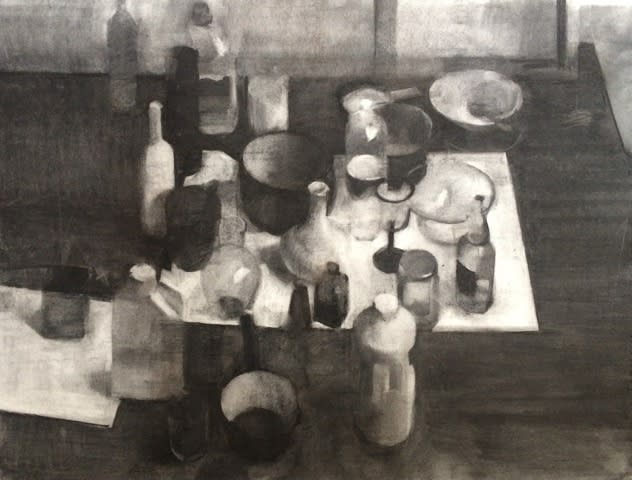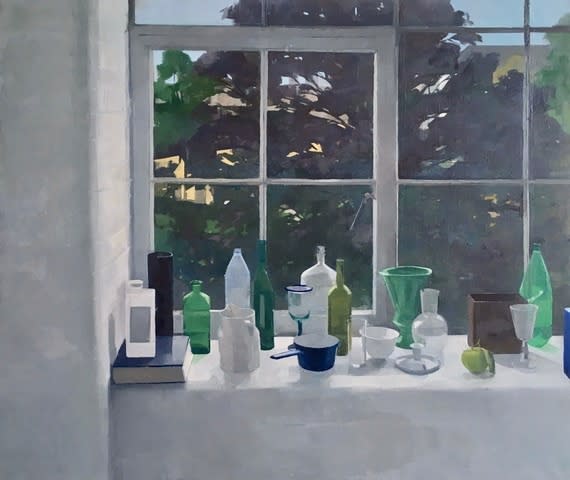We're delighted to bring you an article by Jason Line, one of our newest members, elected in summer 2021. He tells us about his influences and experiences that led him to his focus on still life painting, as well as the process of composition and how elements from music and theatre find their way into his work . . .
"When I was at school, I had the good fortune of being taught by art teachers who gave me a grounding in traditional painting and instilled in me the importance of drawing which I have continued to uphold to this day. Over the years, I have experimented and played around with different approaches to painting particularly when I was at art college but the practice of drawing and painting from observation was never far away.
Although I've always taken an interest in what was going on in the contemporary art world, it was the work of the past masters such as Rembrandt, Velasquez and Titian that I looked to, as well as the older generation of modern artists including Lucian Freud, Frank Auerbach and Euan Uglow, whose practice was based on the act of looking, I felt to be richer and more interesting. I realised from really looking at these artists' work that they weren't just interested in painting the mere surface of an object but rather in searching for something that lay much deeper and hence ultimately, for me, more intellectually and emotionally sustaining.
The human figure and portraiture was the subject that interested me most when I was younger but slowly the still life became the main focus of my work. This was possibly because I couldn't always afford a model or find a friend willing to sit, so a chair, a table, an old pot or whatever I found in the studio now became my models.

Apart from just looking carefully and painting closely the shape, colour and texture of an object, what I've always enjoyed about working with the still life - as opposed to working out in the landscape - is that it offers me a certain freedom and room for invention.

I've always enjoyed the process of composition: of moving objects around and placing one object next to another until something of interest comes about such as the tension that might arise from just placing a dark hard-edged geometric object against a soft and organic light object. The objects I use vary in shape, colour, material and value - whether it's a piece of fruit, an everyday plastic detergent bottle or a beautiful hand-crafted ceramic vase.
Over the years, I have approached the still life in all sorts of different ways, arranging the objects whether they're grouped together, placed on the floor as in 'Floor Arrangement' or just one object on its own, placing it on a high plinth as if it's a prize specimen in a produce show for all the world to see and admire as in 'Sorrento Lemon'.

Recently the paintings have shifted slightly to incorporate not only the objects but also the surrounding area. In 'Summer Arrangement', 'Bottles and Buildings' and 'Autumn Arrangement' all the paintings consist of an assortment of objects assembled on the studio windowsill. The light behind creates a certain drama with the window and the view beyond provides a backdrop of the differing moods of the seasons adding a theatrical element to these paintings.

In another work, 'All Blues', the title of which was taken from Miles Davis' album 'A Kind of Blue', a musical element is evident. The predominately blue objects, arranged carefully next to each other in a row, could be read from left to right as if they are musical notes and symbols: rising, falling and fading into another with the spaces or silence in between being just as important as the objects or notes themselves.

I find with painting, as well as looking there is a certain amount of listening involved. Much like when tuning an instrument, the same goes with painting a still life: a careful adjustment of various tones of colour to find just the right chord. This is definitely apparent in Georgio Morandi's work, an artist who I've looked at closely and long admired. His seemingly simple compositions seem to hum and resonate as if they have transcended their physicality and belong to a different world.

The recent works have also started to include the surrounding interior as in 'Interior with a Lloyd Loom Chair'. The same concerns are still there as when I am working with the still life, but there's now a pulling back to give an increased depth of space taking in the floor, walls and the window, inviting the viewer to not only study the objects but to walk around them as well.

The introduction of an empty chair provides a powerful presence and has been playing a large part recently in my work as has the window. Much of the iconography of this comes from my interest in paintings of domestic interiors particularly those of Vermeer and 17th-century Dutch painting.
As I mentioned earlier, there is a theatrical element to my paintings, and I like to view these new interiors as stage sets. While watching a play, I'm always intrigued when the stage is revealed before the actors come on and we witness a scene of something that has happened, putting you in a state of anticipation as to what is going to happen next. Themes and ideas may formulate within my work but I never set out consciously to make a work from an idea. If there's anything of value to be expressed, I always feel it will come naturally from the simple act of looking at what's in front of me and responding truthfully from the heart."
Find out more about Jason Line on his NEAC profile page where you will also find a selection of his original paintings for sale.







